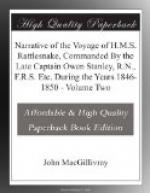(Footnote. For every information required by navigators passing through Bass Strait, I would refer to Discoveries in Australia, with an account of the Coasts and Rivers explored and surveyed during the Voyage of H.M.S. Beagle, in the years 1837 to 1843 by J. Lort Stokes, Commander, R.N., and to the Admiralty chart by Captain Stokes. On this subject I find a manuscript note by Captain Stanley: “Stokes has mentioned in his chart that there is little or no tide in Bass Strait. Such may be the case, but I have invariably found a very strong current, depending both as to force and direction upon the prevailing winds. On one occasion, during a westerly gale, it set to the eastward with a velocity of at least three knots per hour. I mention this circumstance, as from Captain Stokes’ remarks, strangers might be led to suppose there were no currents in the Strait, and neglect to take the usual precautions.”)
(**Footnote. It is unnecessary to give separately the various meridian distances obtained by the Rattlesnake and Bramble, as these will be found, with the various circumstances affecting their value, in the Appendix.)
GOOSE ISLAND.
March 3rd.
With the help of a strong westerly wind we reached Goose Island at 5 P.M., and a party from the ship landed immediately after anchoring. The island is one and a half miles in length, by one in greatest breadth. The rock is a coarse sienite, forming detached bare masses and ridges, but none of considerable height. In the hollows the soil appears rich, dark, and pulverulent, with much admixture of unformed bird-guano. The scanty vegetation is apparently limited to a grass growing in tussocks, and a few maritime plants. The ground resembles a rabbit warren, being everywhere undermined by the burrows of the mutton-bird, a dark shearwater (Puffinus brevicaudus) the size of a pigeon. A person in walking across the island can scarcely avoid frequently stumbling among these burrows, from the earth giving way under his feet, and I was told by one of the residents that snakes are very numerous in these holes, living upon the mutton-birds; I myself trod upon one which, fortunately, was too sluggish to escape before I had time to shoot it, and ascertain it to be the well-known black snake of the Australian colonists (Acanthophis tortor) a very poisonous species. Among the seafowl, a large gull (Larus pacificus) was exceedingly plentiful, together with a smaller one (Xema jamesonii) and a few penguins (Spheniscus minor.) A fine flock of wild geese (Cereopsis novae hollandiae) was seen, but they were too wary to allow of close approach. About dusk clouds of mutton-birds came in from the sea, and we amused ourselves with chasing them over the ground among their burrows, and as many specimens as I required were speedily provided by knocking them down with a stick. As usual with the Petrel family they bite severely if incautiously handled, and disgorge a quantity of offensive oily matter, the smell of which pervades the whole island, a which the clothes I then wore retained for a long time afterwards.




